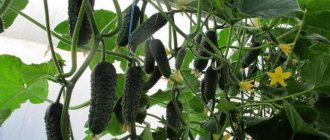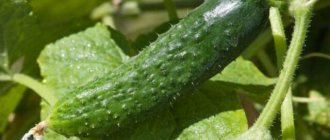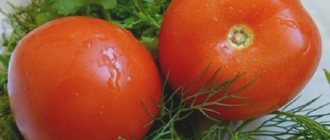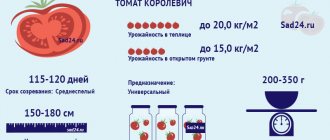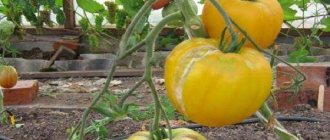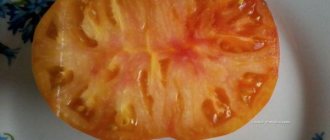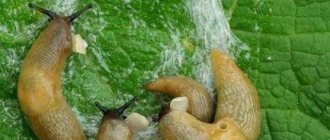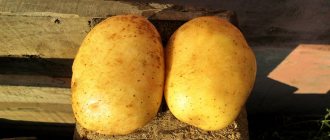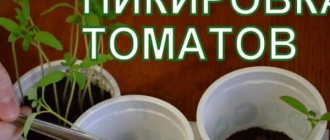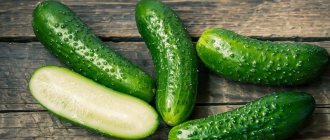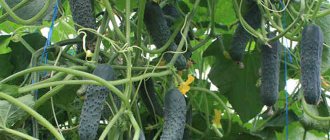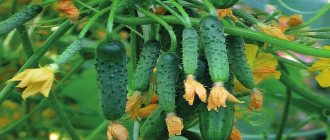Bettina F1 cucumbers are high-quality Dutch hybrids. The seeds are not the cheapest, but the quality is worth it: the hybrid can be grown in any conditions, get a stable early harvest and enjoy fresh vegetables or store them for the winter.
| Landing location | Ripening time | Mode of application | Fruit length | Group | Fruit smoothness | Pollination method |
| Universal | Early ripening (35-45 days) | Universal | Medium - from 10 to 15 cm | Hybrid | Highly lumpy | Parthenocarpic |
Characteristics and description of the variety
Characteristics of Bettina F1 cucumber :
- It is an early ripening variety; fruiting occurs in the period from 38 to 42 days after the seeds emerge.
- The plant belongs to the indeterminate type (not limited in growth), compact, characterized by average growth vigor and branching.
- It is parthenocarpic, i.e. The cucumber develops only female flowers.
- It belongs to the generative type, since most of the fruits are produced by the central stem.
- It does not require the formation of a bush, due to the fact that the growth of vegetative stepsons stops at a plant height of up to 1.5 m, then exclusively generative stepsons develop, which ensure the formation of fruits and do not require removal.
- The color of the leaves is dark green, the leaf blade is medium in size.
- It is distinguished by its rapid yield; most fruits form and ripen within the first month after fruiting begins.
- Can be used for two rotations per season, suitable for winter-spring rotation during early cultivation in a film greenhouse.
- Recommendations for planting density – 3-4 bushes/m. sq.
Description
Bettina F1 fruits :
- the surface of the fruit is smooth and uniform;
- differ in cylindrical shape, short length (7-10 cm);
- the skin is dark green in color, contains short white stripes, large tubercles with brown spines and medium-density pubescence;
- has pulp in which there is no bitterness and emptiness;
- average fruit weight from 60 to 80 g;
- The yield indicator for open ground is 5 kg/m. sq.
Description of cucumbers
The first generation hybrid Bettina was bred by Dutch breeders relatively recently, in 2007. Initially, employees sought to develop cucumbers that would produce high yields even in unfavorable climatic conditions.
As a result, scientists achieved not only their goals, but also created a record holder in terms of crop ripening. Bettina was added to the State Register of the Russian Federation in 2010.
Peculiarities
Gherkin type of cucumber. The hybrid is successfully grown both in open ground and in greenhouse conditions, even on window sills or balconies. The culture is parthenocarpic (self-pollinating). This simplifies the cultivation of vegetables in closed structures where pollinating insects do not enter.
The bushes show the best yield in mild climatic conditions, but tolerate temperature fluctuations well.
Composition and properties
The fruits consist of 90–95% structured water, so they perfectly quench thirst. They contain a large amount of minerals and vitamins A, B1, B2, C, E, PP, H.
Vegetables include:
- phosphorus;
- sodium;
- potassium;
- fructose;
- glucose;
- magnesium;
- calcium;
- iodine;
- carotene;
- starch.
The fruits also contain caffeic, ascorbic and folic acids.
The calorie content per 100 g of product is 10–15 kcal, that is, the product is absolutely dietary. Doctors advise spending a fasting day on cucumbers, during which they eat up to 1–1.5 kg of vegetables.
Nutritional value of fruits:
- proteins - 0.8 g;
- fats - 0.1 g;
- carbohydrates - 3 g.
Alkaline salts in vegetables prevent the formation of sand and kidney stones. Iodine compounds and fiber improve intestinal function.
Characteristics
Bettina hybrid is indeterminate. The ovaries form on the main stem. The lashes are moderately branched. The leaves are medium-light green, but increase in size when grown in a greenhouse. Each leaf axil bears from 1 to 4 fruits. There are more female flowers than male ones.
The length of the cylindrical fruits is 10–13 cm, weight is 60–80 g. The cucumbers have large tubercles and black pubescence. The pulp is juicy, crispy, without bitterness or voids. When preserved, the taste properties are not lost.
The color of vegetables greatly depends on the frequency of moisture and the quality of the soil. In good conditions, the skin is a rich dark green color. If the soil is acidic, yellow spots or stripes appear on the fruits.
Vegetables ripen in a short time: the first harvest is harvested already 40 days after sowing. When cultivated in open ground, about 5 kg of cucumbers are harvested from 1 m2. The quality and quantity of fruits depends on care and the creation of favorable conditions for the growth and development of the crop.
Advantages and disadvantages
Bettina F1 cucumbers are different:
- high productivity;
- unpretentiousness and low maintenance requirements;
- the ability to grow 2 crops during the season, thanks to the early ripening of the fruits;
- resistance to adverse weather conditions, low temperatures, lack of light;
- the ability to pick ripe fruits the size of gherkins and pickles;
- excellent transportability and marketability;
- resistance to diseases affecting cucumbers , such as powdery mildew, cladosporiosis, common mosaic virus, downy mildew.
Among the disadvantages are the high cost of seeds and the impossibility of independently obtaining seeds with parental genes from the second generation of the hybrid.
Recommendations for growing outdoors
Cucumbers “Merengue9raquo; most often grown through seedlings.
Important! Cucumbers do not tolerate damage to the root system well, so they require careful replanting, along with a lump of earth. To preserve fragile roots, it is recommended to grow cucumbers in coconut tablets or briquettes. Growers in reviews do not recommend using peat pots or tablets for growing cucumbers, as they easily lose their shape
Growers in reviews do not recommend using peat pots or tablets for growing cucumbers, as they easily lose their shape
To preserve fragile roots, it is recommended to grow cucumbers in coconut tablets or briquettes. Growers in reviews do not recommend using peat pots or tablets for growing cucumbers, as they easily lose their shape.
In order to get healthy, strong seedlings, you must follow the following rules:
- The soil for growing should be light, free from weed seeds;
- Each plant must be provided with a separate container;
- It is better to plant seedlings later than to plant overgrown plants;
- It is necessary to provide the seedlings with a sufficient amount of ultraviolet radiation, and, if necessary, provide additional illumination;
- Water carefully - excess moisture can destroy the roots of cucumbers;
- Before planting in a permanent place, it is necessary to harden off the seedlings.
Advice! It is advisable to plant cucumber seedlings in the ground in the evening; after planting, it is necessary to water the plants well.
Soil characteristics are of great importance. If acidity is high, it is necessary to add lime or dolomite flour. It is not advisable to water the cucumbers abundantly before planting; a wet earthen lump may lose its shape, which will make it difficult to replant the cucumbers.
Advice! It is advisable to tie grown plants to supports to facilitate harvesting and prevent infection of cucumbers, since many pathogens enter the bush with soil.
It is most convenient to use a coarse mesh stretched over trellises. The leaves of the variety “Merengue9raquo; The fruits are sparsely arranged, the fruits are clearly visible, so harvesting cucumbers is not difficult.
Cucumbers respond well to the application of complex fertilizers; it is advisable to use nutrients in chelated form. Chelated fertilizers are more easily absorbed by the root system of cucumbers and can be effectively used for foliar feeding.
Important! Nitrogenous fertilizers should be used with caution for cucumbers. Excess nitrogen negatively affects the development of cucumbers; their shoots and leaves actively develop, but flowering and fruiting are significantly reduced
Cucumber fruits overfed with nitrogen are poorly stored and become unsuitable for canning.
It is necessary to harvest cucumbers at least once every 4 to 5 days. If you leave the greens on the bush longer, the bush will waste nutrients in vain, in addition, the formation of new fruits will stop.
The cucumber continues to bear fruit until frost. If you provide the cucumber with shelter in the fall, you can significantly prolong fruiting.
Photo
Below are photos the Bettina F1 hybrid
Features of cultivation
All hybrids are distinguished by the fact that they do not require complex care.
Experts recommend using open ground for growing Bettina F1 cucumbers , however, gardeners often plant the variety in a greenhouse or greenhouse. Considering that stable warm weather sets in in most regions of the central zone by May, cucumbers should be sown for seedlings in early April.
In regions with a temperate climate (Ural, Siberia), the dates are shifted to a later time; mid-May is suitable for planting in greenhouses, late spring or early summer - for open ground. Accordingly, seeds for seedlings are sown from mid to late April.
Light, fertile, moderately moist soil is best suited for seedlings.
Reference! Planting scheme – 3-4 plants per 1 sq. meter of bed area.
It’s not scary if the bushes grow very large and cover the neighboring cucumbers from the sun. This does not harm the hybrid, but on the contrary can contribute to better fruiting. Bettina F1 cucumbers are shade-tolerant.
There is no need to form bushes, nor to remove the generative stepsons on which fruits are formed.
to fertilize Bettina F1 cucumbers with mullein diluted in water (1:10), horse manure (1:10), bird droppings (1:20) or wood ash infusion. You can use complex mineral fertilizer, for example, nitrophoska; in addition, superphosphate is useful for the growth and development of cucumbers .
To care for cucumbers, you should implement the following agricultural techniques:
- Water the plants with warm water every day after sunset;
- Feed the bushes weekly with urea, mullein infusion or other fertilizers described above;
- Loosen the soil after watering to retain moisture and saturate the soil at the roots with oxygen.
Planting and caring for the plant
Growing this variety is no different from others. Two methods are used:
- Rassadny.
- Direct sowing into the ground.
For each region, planting dates are calculated individually. Because spring is different for everyone. Using the seedling method of cultivation, the harvest is obtained earlier. But with more effort and time. Because the tender roots of the crop do not tolerate transplantation. Summer residents recommend using peat pots.
When moving to a permanent place, there is no need to injure the plant. Moreover, this container is a fertilizer, decomposing in the ground.
Seeds are sown 2–3 weeks before planting in the ground. Observing light and temperature conditions. Water as needed, avoiding drying out and waterlogging of the soil. Feed with growth stimulants.
Direct sowing into the ground involves preparing holes and seed. Planting depth is 1–1.5 cm. Humus and wood ash are added to the holes. 3–4 plants are planted per 1 m2.
See also
How to properly pick cucumbers at homeRead
Care consists of performing simple agrotechnical techniques:
- Daily watering. The water used is warm. Water after sunset.
- Weekly feeding. You should alternate between urea and mullein infusion.
- Loosening. After watering, it is recommended to loosen the soil; this will retain moisture in the soil and ensure the supply of oxygen to the roots.
There is no need to shape the plant; Bettina F1 does not need this process, since after 1–1.5 m it stops forming stepsons.
Reviews
Studying reviews from summer residents helps to get a more accurate idea of varieties, including Bettina F1 . This also helps to avoid mistakes when growing these cucumbers.
Natalia Medvedeva, Smolensk
Sergey, Moscow
Polina, Krasnoyarsk
Nina, Nizhny Novgorod
Mikhail, Lipetsk
